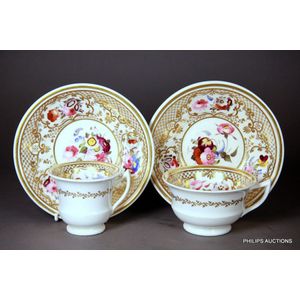Coalport Tea Cups and Saucers, Circa 1830
You must be a subscriber, and be logged in to view price and dealer details.
Subscribe Now to view actual auction price for this item
When you subscribe, you have the option of setting the currency in which to display prices to $Au, $US, $NZ or Stg.
- Emeralds - Emeralds have been used in jewellery making for thousands of years, and are prized for their deep green colour, which is caused by the presence of chromium and vanadium in the mineral beryl. Because of their rare colour, emeralds are often more valuable than diamonds of a similar size and quality. In jewellery making, emeralds are typically cut into round or oval shapes to maximize their color and clarity. They are often set in gold or platinum and used as the centrepiece of a piece of jewellery, such as a ring or necklace. They can also be used in combination with other gems, such as diamonds, to create intricate and beautiful designs.
- Circa - A Latin term meaning 'about', often used in the antique trade to give an approximate date for the piece, usually considered to be five years on either side of the circa year. Thus, circa 1900 means the piece was made about 1900, probably between 1895 and 1905. The expression is sometimes abbreviated to c.1900.
- Polychrome - Made or finished in many colours. For furniture, it is used to indicated a painted finish.
This item has been included into following indexes:
Visually similar items

A forty six piece part Limoges Wg & Co porcelain dinner service, 20th century, with borders of apple green foliage with pink and white roses, comprising: ten dinner and entree plates, eight soup bowls, six side plates, six platters of various sizes, three

Two cups and matching saucers attributed to John rose Coalport, circa 1812-1815 period, the bell shaped cups with pointed handles, finely decorated with floral reserves to richly gilded borders with scrolls, vegetal forms and diaper patterns, unmarked; sha

A Lowestoft tea bowl and saucer, circa 1780 decorated in the oriental rock, fence and peony 'Redgrave' pattern below a red and blue border, height 4.5 cm, (cup) Diameter 13 cm, (saucer)

Pair of Dresden tea cups and saucers
